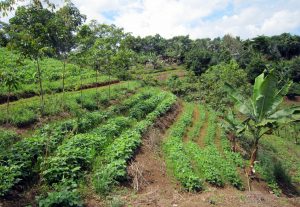- Written by agriadmin
- Published: 09 May 2016

Cote d'Ivoire Agriculture Highlights
- Côte d'Ivoire (Ivory Coast) leads the world in production and export of the cocoa beans used in the manufacture of chocolate, as of 2012, supplying 33% of cocoa produced in the world. (more)
- Ivory Coast, Pulse Nigeria, May 5, 2016 -- Country becomes world's largest exporter of cashew nuts. According to a report by BBC, Ivory Coast have overtaken India to make a statement in the cashew nut industry. (more)
- Côte d'Ivoire is estimated by United States Department of Agriculture to be the 2016 third largest African producer of palm oil. (more)
Agriculture was the foundation of the economy in Côte d'Ivoire and its main source of growth. In 1987 the agricultural sector contributed 35 percent of the country's GDP and 66 percent of its export revenues, provided employment for about two-thirds of the national work force, and generated substantial revenues despite the drop in coffee and cocoa prices. From 1965 to 1980, agricultural GDP grew by an average 4.6 percent per year. Growth of agricultural GDP from coffee, cocoa, and timber production, which totaled nearly 50 percent of Ivory Coast's export revenues, averaged 7 percent a year from 1965 to 1980.
In Ivory Coast 64.8% of the land is agricultural and therefore their economy’s foundation is mostly based on their agriculture. Fifty-five percent of their income come from exports of cocoa and coffee which are both agricultural products.
Contributing to this impressive performance were an abundance of fertile land, cheap labor, the collective efforts of many farmers cultivating small plots, relatively favorable commodity prices, and a stable political environment.
 Success in the 1960s and 1970s overshadowed major problems developing in the agricultural sector. By the late 1980s, despite efforts to diversify its crops, 55 percent of Ivory Coast's export earnings still came from cocoa and coffee. Moreover, highly volatile world markets for both commodities caused sharp fluctuations in government revenues and made development planning difficult. In addition, Ivory Coast was not yet self-sufficient in food production and imported substantial quantities of rice, wheat, fish, and red meat. Finally, despite an enormous increase in the volume of agricultural output since independence, there was little improvement in agricultural productivity. To achieve higher production figures, traditional farmers using traditional technologies simply cleared more and more land.
Success in the 1960s and 1970s overshadowed major problems developing in the agricultural sector. By the late 1980s, despite efforts to diversify its crops, 55 percent of Ivory Coast's export earnings still came from cocoa and coffee. Moreover, highly volatile world markets for both commodities caused sharp fluctuations in government revenues and made development planning difficult. In addition, Ivory Coast was not yet self-sufficient in food production and imported substantial quantities of rice, wheat, fish, and red meat. Finally, despite an enormous increase in the volume of agricultural output since independence, there was little improvement in agricultural productivity. To achieve higher production figures, traditional farmers using traditional technologies simply cleared more and more land.To overcome Ivory Coast's excessive dependence on coffee and cocoa (the prices for which were set by consumers), on timber (the supply of which was nearly exhausted), and on imported food, the government in the mid-1970s embarked on a series of agricultural diversification and regional development projects with the hope of boosting agricultural production by 4 percent per year. The plan, estimated to cost CFA F100 billion per annum (with just over 50 percent coming from foreign lenders) would allow the country to become self-sufficient in food (with the exception of wheat) and expand the production of rubber, cotton, sugar, bananas, pineapples, and tropical oils.
In spite of these efforts, the agricultural sector appeared unable to adapt to changing conditions. Distortions in the system of incentives reduced the comparative advantage of alternative crops. The vast revenues collected by the CSSPPA were often spent on marginally profitable investments, like the costly sugar complexes or expensive land clearing programs. Finally, some diversification crops, like coconut and palm oil, faced new threats as health-conscious consumers in the United States and Europe began turning away from tropical oils. Consequently, the future for Ivoirian agriculture was uncertain.
Agricultural use to eradicate hunger in Ivory Coast
A way that organizations and government official support school feeding was through increasing productivity & income of small-scale farmers and integrating them with the markets. They also try to make communities self sufficient with themselves producing/cultivate their own resources. These two methods both use agricultural land to try and eradicate zero hunger. As they say the only thing that is better than school feeding programs in the fight against hunger are the school feeding programs where the food is sourced locally.
"Agriculture in Ivory Coast." Wikipedia, the Free Encyclopedia. Wikimedia Foundation, Inc., 20 May 2016. Web. 28 June 2016. <https://en.wikipedia.org/wiki/Agriculture_in_Ivory_Coast>.
Agrismart, Inc. Côte d'Ivoire blog | #agrismart #CotedIvoire #CIV #Africa #SustainableAgriculture #SustainableDevelopment #SDGs
Comments Off on Côte d’Ivoire (Ivory Coast) Agriculture

